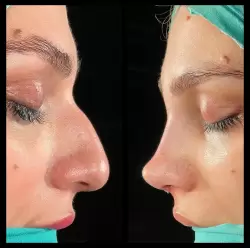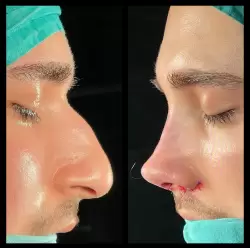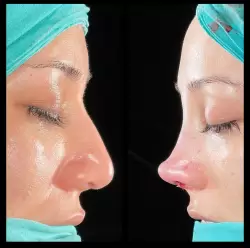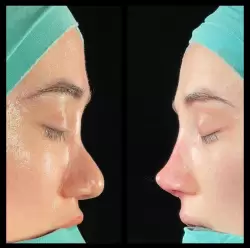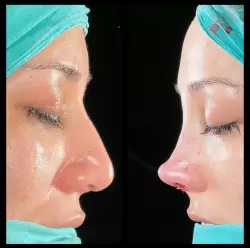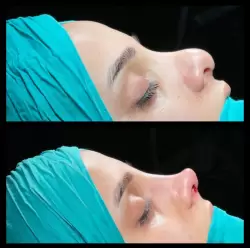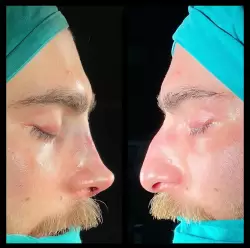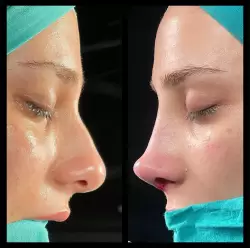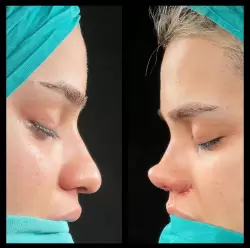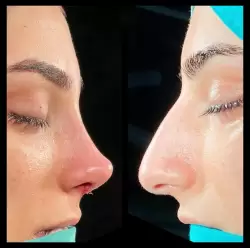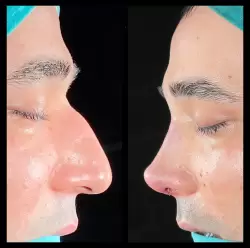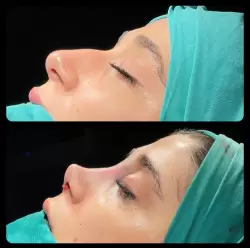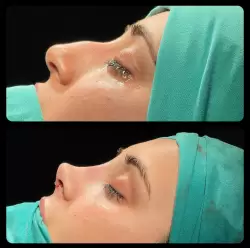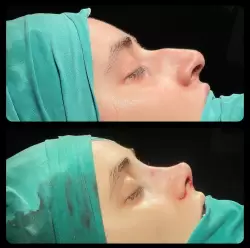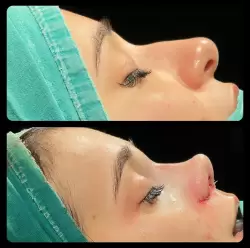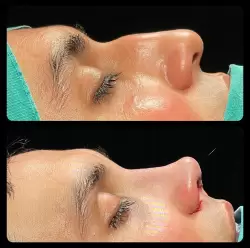Revision rhinoplasty is a surgical procedure performed in patients who are not satisfied with the results of a previous rhinoplasty or who experience complications such as breathing problems. Revision rhinoplasty may be necessary if the shape or function of the nose, or both, are not as expected after the first rhinoplasty.
A revision rhinoplasty may be different from the first rhinoplasty. The anatomy and tissues of the nose may have changed as a result of the changes made during the first operation. Therefore, revision rhinoplasty may be more challenging and complex than the first operation. Revision rhinoplasty can usually be performed using a closed or open technique. The surgeon will evaluate the results of the previous operation and make the necessary changes to improve the shape or function of the nose. These changes may include procedures such as strengthening the cartilage at the tip of the nose, correcting protrusions on the back of the nose, enlarging the nostrils or opening the nasal passages.
Revision rhinoplasty takes longer and can be more difficult than the first operation. Also, depending on the amount of tissue or cartilage used in the first surgery, more tissue or cartilage may be needed for revision rhinoplasty. The skill and experience of the surgeon, and the quality of post-operative care, will greatly influence the outcome of the operation. After revision rhinoplasty, patients must go through a recovery process that requires special care and attention for a period of time. It is important for patients to know that they may experience symptoms such as swelling, bruising, nosebleeds or pain after surgery. The surgeon will discuss postoperative care and activity restrictions with the patient in detail.
Revision rhinoplasty is a good option to correct or improve the results of the first operation. However, because it carries risks and complications, it is important that it is planned and carried out correctly at the time of the first operation.
When is revision rhinoplasty performed?
Revision rhinoplasty is performed to correct the results of a previous rhinoplasty. The results of a failed rhinoplasty can be due to many reasons, including distortion of the shape of the nose, loss of symmetry, breathing difficulties, nasal congestion or narrowing of the nostrils. Revision rhinoplasty can be performed to correct complications that occur after rhinoplasty, as well as deformities that occur after the initial surgery. These complications include nasal infections, nosebleeds, adhesions in the nose, protruding nasal bones or collapse of the tip of the nose. In general, revision rhinoplasty is performed in the following situations:
Unsuccessful results: After the initial operation, the shape, symmetry or proportions of the nose may not form properly. This can lead to a worsening of the nose deformity and cause aesthetic or functional discomfort.
Functional problems: If the structures in the nose (cartilage or bone) were not properly supported after the initial surgery, or if adhesions formed in the nose during the healing process, problems such as nasal congestion, breathing difficulties or chronic nasal infections may occur.
Poor healing: If the healing process did not work properly after the first surgery, problems such as excessive swelling or bruising in the nose, infection or scarring may occur.
New wishes: After the initial operation, the person may have new wishes or changes in the shape or size of the nose. In this case, a revision rhinoplasty may be performed to further improve the shape of the person’s nose.
Trauma or injury: Trauma or injury to the nose after the initial operation may also require revision rhinoplasty.
A revision rhinoplasty should only be performed to correct the results of a previous rhinoplasty and should not be considered a guaranteed procedure to correct the failure of the first surgery.
Who can have revision rhinoplasty?
A number of criteria are looked for in order to be a suitable candidate for revision rhinoplasty. Here are some of them:
Time elapsed since the first operation: At least 1 year should elapse before revision rhinoplasty. This is to allow the nasal tissues to heal and the changes to stabilise.
Health status: Candidates for revision rhinoplasty should undergo a medical examination to demonstrate that they are in good general health. Especially if there are any health problems, such as respiratory problems related to the nose, these should be resolved first.
Expectations: Candidates should have a realistic idea of what to expect after revision rhinoplasty. This begins with a detailed pre-operative consultation. The type of changes candidates want to make to their nose and the type of nose shape and function they expect after surgery are discussed in detail.
Results of previous surgery: In order to be a suitable candidate for revision rhinoplasty, it is necessary for the changes to be possible depending on the results of the previous surgery. In particular, factors such as the adequacy of the nasal tissues and the amount and quality of cartilage should be taken into account.
Psychological status: Candidates for revision rhinoplasty should be psychologically healthy and mature enough to cope with emotional stress and uncertainty following surgery.
In addition to these criteria, it is recommended that suitable candidates for revision rhinoplasty avoid harmful habits such as smoking and alcohol and maintain a healthy lifestyle.
What complications can occur after revision rhinoplasty?
Several complications can occur after revision rhinoplasty, just as they do after the initial surgery. These may include
Bleeding: Post-operative nose bleeding may occur. This is usually minimal or moderate and stops spontaneously. However, if excessive bleeding occurs, additional treatment may be required.
Infection: Infection can occur in the nose after surgery. Treatment with antibiotics may be required.
Allergic reactions: Some patients may have allergic reactions to nasal fillers or anaesthetics.
Asymmetry: As a result of the second operation, the nose may not be symmetrical or the tip of the nose may drop. This may require a second operation.
Breathing problems: After the second operation, the nose may cause congestion or other breathing problems.
Scars: Some patients may develop permanent scars on the nose after revision rhinoplasty.
Anaesthetic risks: Anaesthesia for revision rhinoplasty carries the same risks as any other surgery. These risks can include changes in blood pressure, slowing or speeding up of the heartbeat, breathing problems and other anaesthesia-related complications.
Taking care of yourself after revision rhinoplasty according to your doctor’s instructions can help reduce the risks.
How long does revision rhinoplasty take?
The length of revision rhinoplasty can vary depending on many factors. These may include factors such as the patient’s nasal anatomy, the complexity of the surgery, and the number of procedures performed on the nose. In general, revision rhinoplasty take longer than the first operation. This may be because the changes made after the previous operation can make the second operation more complex. Although it takes longer than the first operation, revision rhinoplasty usually takes about 2-3 hours. However, more complex cases may take longer. The length of the operation may also depend on the patient’s health and the type of anaesthetic used. Therefore, it may not be possible to give an exact estimate of the surgery time.
Frequently Asked Questions About Rhinoplasty
How Long Does Nose Aesthetic Surgery Take?
The duration of rhinoplasty surgery may vary depending on the scope of the surgery, the procedures to be performed and the patient’s condition. Generally, rhinoplasty operations take between 1-3 hours. However, more complex procedures or revision surgeries may take longer. In addition, factors such as the pre-operative preparation process, application of anesthesia and entering the operating room can affect the total time. Therefore, how long the rhinoplasty surgery will take may be different for each patient.
Which Age Range Is Suitable For Nose Aesthetic Surgery?
The appropriate age range for rhinoplasty surgery is generally 18 years and above, after the adolescence period when the nose development is completed. However, in some exceptional cases, it may be necessary to perform the surgery at an earlier age, for reasons such as a congenital deformity of the nose shape or an accidental deterioration. Rhinoplasty surgery is generally recommended to be performed after the adolescence period, when the nose structure of the person is fully developed. The reason for this is that with the completion of the nose structure, the shape of the nose becomes clear and the surgical result becomes more predictable. However, since each person’s nose structure and needs are different, there is no definite rule about the appropriate age range for surgery. Therefore, it is better to consult with your doctor before the operation.
How Long Does the Nose Shape Take After Nose Aesthetic Surgery?
The shape of the nose after rhinoplasty may change during the healing process. The nose may be full of swelling and bruises for the first few days after surgery. Therefore, it may take several weeks or even several months until the nose shape is fully defined. In the first few weeks, the nose may swell due to edema and bruises, which can cause changes in the shape of the nose. During the healing process, the shape of the nose will gradually become clearer and time will be required for the nasal bones and cartilages to settle in place. It is important to be patient and act in accordance with the healing process until the nose shape is fully formed after rhinoplasty.

